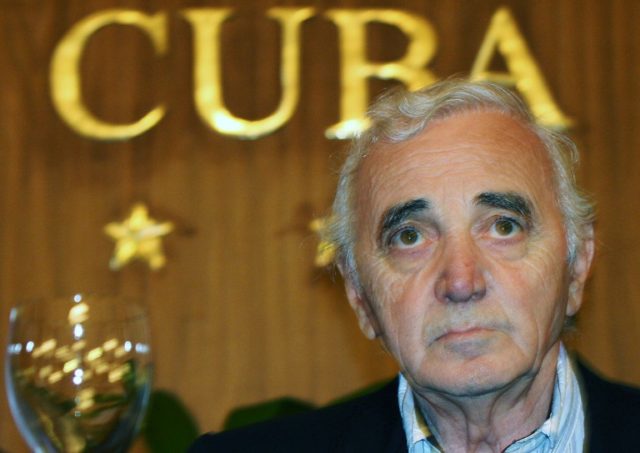Havana (AFP) – As France mourned legendary singer Charles Aznavour this week, his songs of love and loss blared in Spanish on radios across the Atlantic in Cuba, where he had a loyal following and experimented with Caribbean rhythms.
Jazz pianist Chucho Valdes vividly remembers the day in 2006 when he got a call from Aznavour’s team proposing that the two work together on an album.
“At first, I didn’t really believe it. I thought someone was playing a joke on me,” the 76-year-old Valdes told AFP by phone from the United States, where he now lives.
Aznavour had been a star for decades on the Caribbean island nation: the French-Armenian singer translated many of his hits into Spanish, a language he did not speak but managed to mimic with aplomb.
Valdes has a pretty high profile himself: the bandleader, composer and pianist is a fixture in the worlds of jazz and Cuban music.
But he says he was still “shocked” when Aznavour’s producer asked him to “lend some Cuban flavor, Caribbean flavor” to the crooner’s melodies.
“All my life, I had seen Charles Aznavour as the greatest artist who ever walked the planet,” Valdes said.
For Aznavour, it was a chance to realize an old musical dream — to go to the island nation, then led by Fidel Castro, and record.
– Cha-cha –
Aznavour first toyed with using a Cuban sound in 1961, with his French-language version of Ramon Cabrera’s cha-cha “Esperanza.”
He went a step farther in 1999, when he recorded a Spanish version of “Mourir d’aimer” (“To Die of Love”) in Paris with the help of Compay Segundo, one of the founders of the Buena Vista Social Club, and Hugo Garzon, the singer in Segundo’s group.
Aznavour was the one who initiated the unusual trio.
“We accepted, we were so happy to sing with a giant of French music,” Garzon said, noting that he felt “great pride” about the collaboration.
“The Cuban people always loved Charles Aznavour, ever since the 1960s and 1970s,” he said.
“His songs will live on in our hearts,” he added, before getting up and singing a few bars from “Mourir d’aimer” a cappella.
– Havana sessions –
In 2006, Aznavour headed to Havana for the first time, hoping to put the finishing touches on his album, “Colore ma vie” (“Color My Life”).
He set foot in the Cuban capital with 10 songs, and Valdes went to work.
“I did some Cuban-style arrangements,” Valdes said modestly.
The duo recorded in the famed Abdala studios, where all of Cuba’s top artists have worked.
“Beforehand, we rehearsed at the Hotel Nacional, where Aznavour was staying,” recalls Valdes, referring to the historic hotspot.
“He stayed for about 10 days. He had time to see Havana, the Old City, and wherever he went, everyone recognized him. it was incredible — they asked him for autographs, and took photos with him.”
The result? An album, which came out a few months later, infused with a jazzy, Latin vibe.
– ‘Icon’ –
Before heading back to Paris, Aznavour had dinner with several Cuban singers, including Silvio Rodriguez and Amaury Perez Vidal, who said he could not forget “the most elegant man I ever knew.”
“It was really something when he arrived because — and several of us said this — we started recording songs because he did,” Perez told AFP.
Aznavour, dressed in a blue suit with golden buttons, lit a cigar at the end of the meal as he listened to his Cuban peers talk about how the island was fascinated by the Frenchman’s music.
“He thought he had come here… and would be taken for just some Frenchman who came here to record,” Perez said. “He didn’t realize that he was an icon, not just of French culture, but of Cuban culture.”
“Charles Aznavour is like Compay Segundo!” exclaims Carlos Mesa, a 62-year-old plumber dancing to “Venecia sin ti” — the Spanish version of Aznavour’s “Que c’est triste, Venise” — played by a Havana salsa band.
“A friend has died.”
Aznavour was to be buried on Saturday near Paris. He died on Monday at age 94.

COMMENTS
Please let us know if you're having issues with commenting.